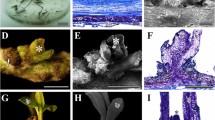Abstract
This study assessed the shoot regeneration capacity of root-tips isolated from single seed-derived individual plants, obtained from a wild, open-pollinated micropopulation of shallot (Allium ascalonicum). Considerable variation was observed in the regeneration capacities of individual lines, ranging from 0.93 to 100 %, and a mean bud number per root explant between 0.09 and 20.67. One line was found to be superior, and was chosen for protocol optimization, focusing on the 2,4-D/BA ratio, duration of the CI phase and light conditions. The application of the optimized protocol to other lines, selected for their variable regeneration capacities, enhanced the process of regeneration and shortened the time required to obtain healthy plantlets, even in inferior lines. However, highly responsive lines remained superior, indicating that differences at the individual level must not be overlooked. The conditions employed in this study may serve as a base to facilitate the application of molecular breeding methods in shallot.



Similar content being viewed by others
Abbreviations
- ANOVA:
-
Analysis of variance
- BA:
-
6-Benzylaminopurine
- BFC:
-
Bud-forming capacity
- CI:
-
Callus induction
- CIM:
-
Callus induction medium
- 2,4-D:
-
2,4-Dichlorophenoxyacetic acid
- IBA:
-
Indole-3-butyric acid
- Kin:
-
6-Furfurylaminopurine
- MS:
-
Murashige and Skoog mineral solution
- PGR:
-
Plant growth regulator
- RI:
-
Regeneration induction
- RIM:
-
Regeneration induction medium
References
Ahn YK, Yoon MK, Jeon JS (2013) Development of an efficient Agrobacterium-mediated transformation system and production of herbicide-resistant transgenic plants in garlic (Allium sativum L.). Mol Cells 36:158–162
Alizadeh B, Royandazagh SD, Khawar KM, Özcan S (2013) Micropropagation of garlic chives (Allium tuberosum Rottl. ex Sprang) using mesocotyl axis. J Anim Plant Sci 23:543–549
Anami SE, Mgutu AJ, Taracha C, Coussens G, Karimi M, Hilson P, Van Lijsebettens M, Machuka J (2010) Somatic embryogenesis and plant regeneration of tropical maize genotypes. Plant Cell Tissue Organ Cult 102:285–295
Ayabe M, Sumi S (1998) Establishment of a novel tissue culture method, stem-disc culture and its practical application to micropropagation of garlic (Allium sativum L.). Plant Cell Rep 17:773–779
Barandiaran X, Martín N, Rodríguez-Conde MF, Di Pietro A, Martín J (1999a) Genetic variability in callus formation and regeneration of garlic (Allium sativum L.). Plant Cell Rep 18:434–437
Barandiaran X, Martín N, Alba C, Rodríguez-Conde MF, Di Pietro A, Martín J (1999b) An efficient method for the in vitro management of multiple garlic accessions. In Vitro Cell Dev Biol Plant 35:466–469
Bohanec B, Jakše M (1999) Variations in gynogenic response among long-day onion (Allium cepa L.) accessions. Plant Cell Rep 18:737–742
Bohanec B, Jakše M, Ihan A, Javornik B (1995) Studies of gynogenesis in onion (Allium cepa L.): induction procedures and genetic analysis of regenerants. Plant Sci 104:215–224
Eady CC, Butler RC, Suo Y (1998) Somatic embryogenesis and plant regeneration from immature embryo cultures of onion (Allium cepa L.). Plant Cell Rep 18:111–116
Eady CC, Weld R, Lister C (2000) Agrobacterium tumefaciens-mediated transformation and transgenic-plant regeneration of onion (Allium cepa L.). Plant Cell Rep 19:376–381
Eady CC, Davis S, Catanach A, Kenel F, Hunger S (2005) Agrobacterium tumefaciens-mediated transformation of leek (Allium porrum) and garlic (Allium sativum). Plant Cell Rep 24:209–215
Eady CC, Kamoi T, Kato M, Porter NG, Davis S, Shaw M, Kamoi A, Imai S (2008) Silencing onion lachrymatory factor synthase causes a significant change in the sulfur secondary metabolite profile. Plant Physiol 147:2096–2106
Fereol L, Chovelon V, Causse S, Michaux-Ferriere N, Kahane R (2002) Evidence of a somatic embryogenesis process for plant regeneration in garlic (Allium sativum L.). Plant Cell Rep 21:197–203
Haque MS, Wada T, Hattori K (1997) High frequency shoot regeneration and plantlet formation from root tip of garlic. Plant Cell Tissue Organ Cult 50:83–89
Haque MS, Wada T, Hattori K (1998) Efficient plant regeneration in garlic through somatic embryogenesis from root tip explants. Plant Prod Sci 1:216–222
Holmgren PK, Holmgren NH (2003) Additions to Index Herbariorum (Herbaria), edition-8 fourteenth series. Taxon 52:385–389
Javornik B, Bohanec B, Campion B (1998) Second cycle gynogenesis in onion Allium cepa L., and genetic analysis of the plants. Plant Breed 117:275–278
Kahane R, Rancillac M, Teyssendier de la Serve B (1992) Long-term multiplication of onion (Allium cepa L.) by cyclic shoot regeneration in vitro. Plant Cell Tissue Organ Cult 28:281–288
Kenel F, Eady CC, Brinch S (2010) Efficient Agrobacterium tumefaciens-mediated transformation and regeneration of garlic (Allium sativum) immature leaf tissue. Plant Cell Rep 29:223–230
Kondo T, Hasegawa H, Suzuki M (2000) Transformation and regeneration of garlic (Allium sativum L.) by Agrobacterium-mediated gene transfer. Plant Cell Rep 19:989–993
Lagunes-Fortiz E, Robledo-Paz A, Gutiérrez-Espinosa MA, Mascorro-Gallardo JO, Espitia-Rangel E (2013) Genetic transformation of garlic (Allium sativum L.) with tobacco chitinase and glucanase genes for tolerance to the fungus Sclerotium cepivorum. Afr J Biotechnol 12:3482–3492
Li JR, Zhuang FY, Ou CG, Hu H, Zhao ZW, Mao JH (2013) Microspore embryogenesis and production of haploid and doubled haploid plants in carrot (Daucus carota L.). Plant Cell Tissue Organ Cult 112:275–287
Luciani GF, Mary AK, Pellegrini C, Curvetto NR (2006) Effects of explants and growth regulators in garlic callus formation and plant regeneration. Plant Cell Tissue Organ Cult 87:139–143
Luthar Z, Bohanec B (1999) Induction of direct somatic organogenesis in onion (Allium cepa L.) using a two-step flower or ovary culture. Plant Cell Rep 18:797–802
Marchionni Basté E, Pratta GR, Zorzoli R (2007) Genetic analysis of the in vitro culture response in tomato. Plant Cell Tissue Organ Cult 88:233–239
Martín-Urdíroz N, Garrido-Gala J, Martín J, Barandiaran X (2004) Effect of light on the organogenic ability of garlic roots using a one-step in vitro system. Plant Cell Rep 22:721–724
Milojević J, Tubić Lj, Zdravković-Korać S, Dragićević I, Ćalić-Dragosavac D, Vinterhalter B (2011) Increased regeneration capacity in spinach lines obtained by in vitro self-fertilisation. Sci Hortic 130:681–690
Mishra R, Wang HY, Yadav NR, Wilkins TA (2003) Development of a highly regenerable elite Acala cotton (Gossypium hirsutum cv. Maxxa)—a step towards genotype-independent regeneration. Plant Cell Tissue Organ Cult 73:21–35
Mohamed-Yasseen Y, Splittstoesser WE, Litz RE (1994) In vitro shoot proliferation and production of sets from garlic and shallot. Plant Cell Tissue Organ Cult 36:243–247
Mukhopadhyay MJ, Sengupta P, Mukhopadhyay S, Sen S (2005) In vitro stable regeneration of onion and garlic from suspension culture and chromosomal instability in solid callus culture. Sci Hortic 104:1–9
Murashige T, Skoog F (1962) A revised medium for rapid growth and bio assays with tobacco tissue cultures. Physiol Plant 15:473–497
Myers JM, Simon PW (1998) Continuous callus production and regeneration of garlic (Allium sativum L.) using root segments from shoot tip-derived plantlets. Plant Cell Rep 17:726–730
Myers JM, Simon PW (1999) Regeneration of garlic callus as affected by clonal variation, plant growth regulators and culture conditions over time. Plant Cell Rep 19:32–36
Novak FJ (1980) Phenotype and cytological status of plants regenerated from callus culture of Allium sativum L. Z Pflanzenzuecht 84:250–260
Popelka JC, Altpeter F (2003) Evaluation of rye (Secale cereale L.) inbred lines and their crosses for tissue culture response and stable genetic transformation of homozygous rye inbred line L22 by biolistic gene transfer. Theor Appl Genet 107:583–590
Ramakrishnan M, Ceasar SA, Duraipandiyan V, Daniel MA, Ignacimuthu S (2013) Efficacious somatic embryogenesis and fertile plant recovery from shoot apex explants of onion (Allium cepa. L.). In Vitro Cell Dev Biol Plant 49:285–293
Robledo-Paz A, Villalobos-Arâmbula VM, Jofre-Garfias AE (2000) Efficient plant regeneration of garlic (Allium sativum L.) by root-tip culture. In Vitro Cell Dev Biol Plant 36:416–419
Robledo-Paz A, Cabrera-Ponce JL, Villalobos-Arámbula VM, Herrera-Estrela L, Jofre-Garfias AE (2004) Genetic transformation of garlic (Allium sativum L.) by particle bombardment. HortSci 39:1208–1211
Scotton DC, Benedito VA, de Molfetta JB, Rodrigues BI, Tulmann-Neto A, Figueira A (2013) Response of root explants to in vitro cultivation of marketable garlic cultivars. Hortic Bras 31:80–85
Shuto H, Abe T, Sasahara T (1993) In vitro propagation of plants from root apex-derived calli in chinese chive (Allium tuberosum Rottler) and garlic (Allium sativum L.). Jpn J Breed 43:349–354
Sulistyaningsih E, Yamashita K, Tashiro Y (2002) Haploid induction from F1 hybrids between CMS shallot with Allium galanthum cytoplasm and common onion by unpollinated flower culture. Euphytica 125:139–144
Sulistyaningsih E, Aoyagi Y, Tashiro Y (2006) Flower bud culture of shallot (Allium cepa L. Aggregatum group) with cytogenetic analysis of resulting gynogenic plants and somaclones. Plant Cell Tissue Organ Cult 86:249–255
Umehara M, Sueyoshi T, Shimomura K, Iwai M, Shigyo M, Hirashima K, Nakahara T (2006) Interspecific hybrids between Allium fistulosum and Allium schoenoprasum reveal carotene-rich phenotype. Euphytica 148:295–301
Xu Z, Um YC, Kim CH, Lu G, Guo DP, Liu HL, Bah AA, Mao A (2008) Effect of plant growth regulators, temperature and sucrose on shoot proliferation from the stem disc of Chinese jiaotou (Allium chinense) and in vitro bulblet formation. Acta Physiol Plant 30:521–528
Zdravković-Korać S, Milojević J, Tubić Lj, Ćalić-Dragosavac D, Mitić N, Vinterhalter B (2010) Somatic embryogenesis and plant regeneration from root sections of Allium schoenoprasum L. Plant Cell Tissue Organ Cult 101:237–244
Zhang W, Lin X, Takano H, Takio S, Ono K (2004) Efficient plant regeneration from suspension cells of Allium cepa L. Plant Cell Rep 23:371–376
Zhao XY, Su YH, Zhang CL, Wang L, Li XG, Zhang XS (2013) Differences in capacities of in vitro organ regeneration between two Arabidopsis ecotypes Wassilewskija and Columbia. Plant Cell Tissue Organ Cult 112:65–74
Zheng S, Henken B, Sofiari E, Jacobsen E, Krens FA, Kik C (1998) Factors influencing induction, propagation and regeneration of mature zygotic embryo-derived callus from Allium cepa. Plant Cell Tissue Organ Cult 53:99–105
Zheng S, Henken B, Sofiari E, Keizer P, Jacobsen E, Kik C, Krens F (1999) Effect of cytokinins and lines on plant regeneration from long-term callus and suspension cultures of Allium cepa L. Euphytica 108:83–90
Zheng SJ, Henken B, Krens FA, Kik C (2003) The development of an efficient cultivar-independent plant regeneration system from callus derived from both apical and non-apical root segments of garlic (Allium sativum L.). In Vitro Cell Dev Biol Plant 39:288–292
Zheng SJ, Henken B, Ahn YK, Krens FA, Kik C (2004) The development of a reproducible Agrobacterium tumefaciens transformation system for garlic (Allium sativum L.) and the production of transgenic garlic resistant to beet armyworm (Spodoptera exigua Hübner). Mol Breed 14:293–307
Acknowledgments
The authors would like to express their gratitude to the Ministry of Education, Science and Technological Development of the Republic of Serbia for financial support through Contract Nos. 173015 and 173030.
Author information
Authors and Affiliations
Corresponding author
Rights and permissions
About this article
Cite this article
Tubić, L., Anačkov, G., Milojević, J. et al. High variability in the tissue culture response of root-tips of Allium ascalonicum individuals and optimization of the regeneration procedure. Plant Cell Tiss Organ Cult 118, 101–110 (2014). https://doi.org/10.1007/s11240-014-0465-9
Received:
Accepted:
Published:
Issue Date:
DOI: https://doi.org/10.1007/s11240-014-0465-9




